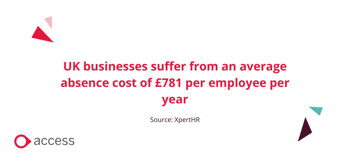
The challenges of multi-location absence management
Managing absence in a large, distributed workforce presents a unique blend of operational and legal challenges:
- Policy inconsistency: Different offices interpreting absence rules differently.
- Lack of visibility: HR teams struggle to see absence trends across departments or countries.
- Legal risk: Sickness absence policies vary significantly across jurisdictions.
- Increased admin burden: Manual reporting, duplicated processes, and slow escalation.
For enterprises with hundreds or thousands of employees, even small inefficiencies can snowball into productivity losses, increased absence costs, and deteriorating employee wellbeing across the organisation.
Understanding regional compliance differences
One of the biggest challenges for multi-national HR teams is navigating local employment law.
For example, in the UK, employees qualify for Statutory Sick Pay (SSP) after three consecutive days. In Ireland, employees are entitled to up to five days of paid sick leave annually as of 2024. Other EU nations differ again, with varied requirements for medical certification to rules on paid vs unpaid leave.
If your systems don’t support country-specific rules, you could be at risk of both non-compliance and employee dissatisfaction. Many modern HR systems will have automatic updates for regulatory compliance, so you can always be safe in the knowledge that you’re operating within the rules.
The operational cost of poor absence management
For large businesses, absenteeism can become more than a HR admin issue as repeated and habitual absence from work can negatively impact business performance.
Industry reports suggest that UK businesses suffer from an average absence cost of £781 per employee per year. (XpertHR, 2022) For larger businesses, the consequences multiply: team schedules can collapse, project timelines slip, overtime costs rise, and healthy employees are left to pick up the slack. This can have a negative impact on employee wellbeing, which is one of the key drivers of performance. For larger businesses, the consequences multiply: team schedules collapse, project timelines slip, overtime costs rise, and healthy employees are left to pick up the slack.
When absence isn't tracked or managed efficiently, it leads to burnout, disengagement, and reputational harm. Tackling absenteeism is an important consideration for large businesses; if you’re keen to learn more about absenteeism and discover strategies to reduce it, read our article on 7 Ways To Effectively Reduce Absenteeism in the Workplace.

Best practices for managing absence at scale
To overcome these challenges, we’ve detailed several principles modern HR operations can follow:
Standardise absence policies with local flexibility
Create a global absence policy framework with clear principles around eligibility, documentation, and return-to-work. Then allow regional HR teams to tailor those policies to reflect local laws and cultural expectations. Your HR system can help you tailor policies based on the local laws and support your employees in surfacing the necessary regulatory documents. Access PeopleXD Evo, for example, has an AI Copilot that can answer absence related questions with reference to company policies and documentation.
Track Absence in Real Time
Modern employee absence management systems can provide HR teams with comprehensive, real-time visibility through live dashboards that span all sites and locations. These platforms typically offer the ability to filter data by location, team, department, or absence type, enabling HR professionals to quickly identify trends and patterns that might otherwise remain hidden in manual systems.
The most effective solutions allow users to drill down into specific areas of concern, such as repeat absences within teams or unusual patterns that could indicate workplace issues, seasonal trends, or emerging health concerns. This granular level of analysis enables HR teams to move from reactive absence management to a more strategic, preventative approach. This can be particularly beneficial in industries like retail, manufacturing, and hospitality, where seasonality causes repeated issues. This HR tech challenge is one of the ones we provide a solution to in our Actionable guide to navigating HR tech challenges in retail, manufacturing and hospitality sectors.
Advanced reporting capabilities can also highlight comparative absence rates between locations, helping organisations understand whether certain sites face unique challenges that require targeted intervention.
Automate your absence workflows
Automating absence management wherever possible can significantly reduce administrative burden whilst minimising human error. Modern systems offer sophisticated workflow capabilities that can transform how organisations handle routine absence processes. Effective automation typically includes:
- Triggering alerts when thresholds are reached (e.g. 5 days in 90 days)
- Automatically applying local rules (e.g. carryover entitlements)
- Initiating return-to-work interviews via digital workflow
These automated processes help ensure that critical absence management steps aren't missed, particularly in large organisations where manual tracking becomes unwieldy. The result is more consistent application of policies and faster response times when employees need support.
Empower line managers
Inconsistency between line managers represents one of the biggest risks in multi-location absence management. When managers interpret policies differently or lack confidence in handling absence situations, it can lead to employee relations issues and compliance gaps. Equip them with:
- Simple self-service dashboards providing clear visibility of absence
- Training on absence escalation
- Pre-configured workflows and policy guidance
Line managers often serve as the frontline of absence culture, making their early conversations with employees crucial for successful outcomes. Providing them with standardised tools and clear guidance helps ensure consistent, supportive approaches across all locations.
Using analytics to drive better decisions
Enterprise absence systems can do far more than simply log data. The most effective solutions surface actionable insights that enable strategic decision-making. PeopleXD Evo for example, has powerful People Analytics providing real-time workforce intelligence, helping your make faster, data-driven decisions. Paired with the AI Copilot, you can start to easily diagnose trends, pinpoint challenges, accelerate your business impact, and utilise AI to interrogate data and uncover practical solutions.
Look for solutions that help you:
- Identify absence hotspots by department or location
- Spot early signs of burnout or poor management
- Forecast demand for cover or support resources
- Measure the impact of wellbeing initiatives over time
For example, if customer service teams in one location show double the absence rate of others, that could highlight a workload or leadership issue. With data, HR can act with purpose.
Absence tracking technology that scales with your organisation
When choosing an absence management solution, make sure it meets enterprise demands:
- Supports multi-country compliance and localisation
- Enables real-time visibility across the organisation
- Integrates with payroll, scheduling and timekeeping
- Offers mobile access for employees and line managers
- Provides analytics for both HR and operational leads
Systems like this help automate the repetitive, standardise the inconsistent, and elevate absence from admin to strategic insight. Not all systems will cover your pain points so it’s important to approach the selection process with a clear idea of your requirements. If you feel ready to approach vendors, check out our Go to market checklist. This practical checklist and evaluation toolkit is designed for HR, IT, Finance, and Procurement leaders tasked with selecting a long-term HR tech partner. Packed with expert insights and hard-earned lessons, this guide helps you separate shiny demos from scalable solutions, helping you can avoid costly mistakes and choose tech that works for your people and your goals.
Why traditional absence tracking falls short
Spreadsheets, paper forms, and outdated HR systems offer no visibility, especially across distributed teams. Even where self-service portals exist, they’re often underused or lack real-time insights. Manual processes also increase the risk of errors and delays, potentially extending absence duration unnecessarily.
That’s why many HR leaders are now asking:
“How do we track employee absences across multiple locations — and take action quickly?”
The answer lies in adopting technology that provides comprehensive visibility whilst automating routine processes.
Align absence management with business outcomes
Effective absence management extends beyond simply tracking who's away from work. It involves understanding the underlying reasons for absence and how these patterns impact broader business objectives. Trends in long-term sickness, stress-related absence, or location-specific hotspots can provide valuable insights that inform strategic decisions around wellbeing programmes, workload distribution, and workforce planning.
Final Thoughts
Managing absence across multiple offices and countries in 2025 requires more than a policy doc and spreadsheet. For HR teams in growing or global organisations, absence is a litmus test for operational maturity, employee experience, and compliance readiness.
By investing in the right systems and processes, you can ensure your organisation:
- Stays compliant
- Supports wellbeing
- Plans better
- And responds faster.
Multi-location absence management requires sophisticated solutions that can adapt to local requirements whilst providing visibility across the whole organisation. Modern platforms can offer the automation, analytics, and scalability that large organisations need to transform their processes.
For more tips on managing employee absence, check out our 7 Ways To Effectively Reduce Absenteeism in the Workplace.
If you’re ready to elevate and transform your absence management process, discover how our solution can help you streamline processes, ensure compliance, and gain the insights you need to support your distributed workforce effectively. Explore our absence management solution or download our brochure and see how we're helping organisations like yours transform their approach to absence management.

 AU & NZ
AU & NZ
 SG
SG
 MY
MY
 US
US
 IE
IE
